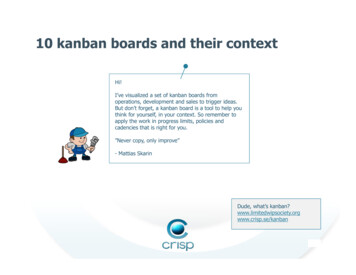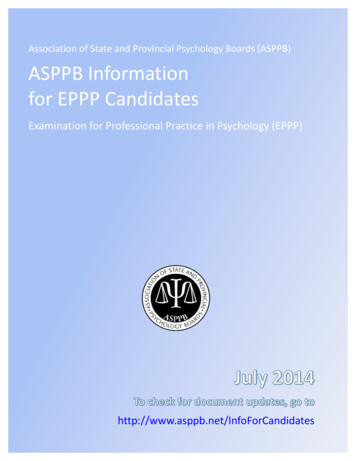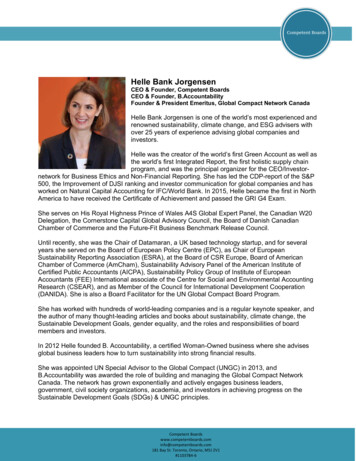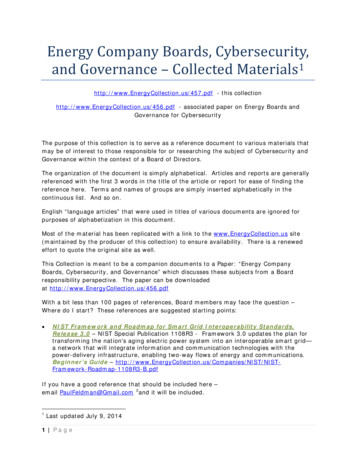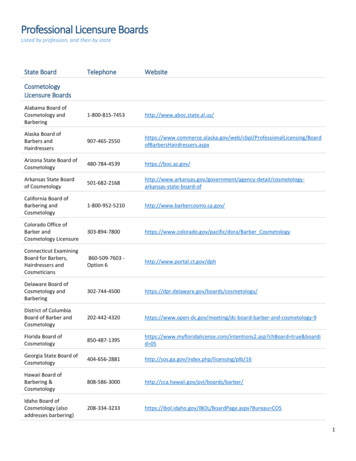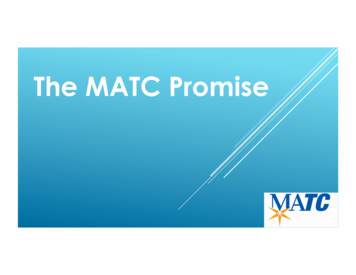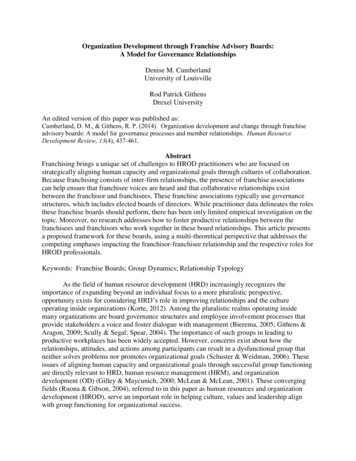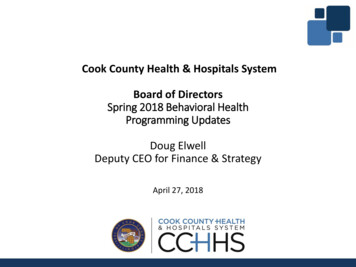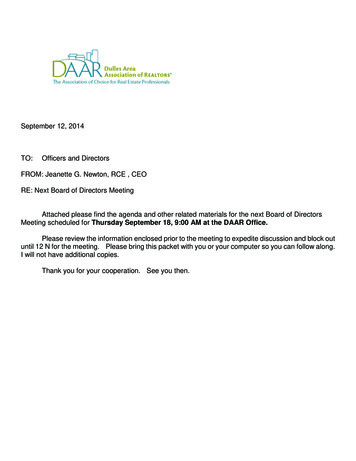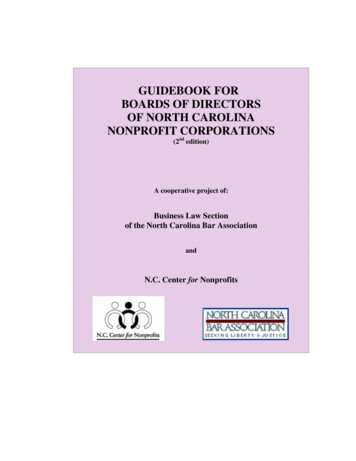
Transcription
GUIDEBOOK FORBOARDS OF DIRECTORSOF NORTH CAROLINANONPROFIT CORPORATIONS(2nd edition)A cooperative project of:Business Law Sectionof the North Carolina Bar AssociationandN.C. Center for Nonprofits
ACKNOWLEDGMENTSThis guidebook reflects a collaborative effort. The idea of a reference book outlining the roles andresponsibilities of board members of North Carolina nonprofit corporations arose from conversationsbetween the Executive Council of the Business Law Section of the N.C. Bar Association and the N.C.Center for Nonprofits. With guidance and encouragement from Steve Poe and Tom Watkins (successivechairs of the Executive Council) and Trisha Lester (vice president of the Center), the project evolvedand took form over a couple of years.Primary thanks to the principal drafters, a team of attorney volunteers of the Business Law Section: Jean Brooks - Brooks, Pierce, McLendon, Humphrey & Leonard, LLP (Greensboro) Benji Jones - Smith Anderson Blount Dorsett Mitchell & Jernigan, LLP (Raleigh) Tom Lyon - Maupin Taylor & Ellis PA (Raleigh) Alan Palmiter - Wake Forest University, School of Law (Winston-Salem)Special thanks to reviewers: Ranlet Bell - Womble Carlyle Sandridge & Rice PLLC (Winston-Salem) David Kyger - Smith Moore LLP (Greensboro) Sally Migliore, N.C. Center for Nonprofits (Raleigh) Alan Briggs, Save Our State (Raleigh) Robert Epting, Epting & Hackney (Chapel Hill)The initial printing of the guidebook was funded by the Business Law Section. Additional copies andupdates can be downloaded without charge from the websites of the Business Law Section and the N.C.Center for Nonprofits.http://business.ncbar.org/Legal ofits.orgFebruary 2003Trisha Lester, N.C. Center for NonprofitsAlan Palmiter, Wake Forest UniversityNOTE ON THE SECOND EDITIONThis guidebook was revised, updated and expanded in 2008. Special thanks to David Heinen, EricJohnson, David Kyger, Alan Palmiter, and Whitney Passmore.Copyright 2008.This guidebook may be copied (in whole or in part)if the full names of the sponsoring organizations are included.
GUIDEBOOK FOR BOARDS OF DIRECTORSOF NORTH CAROLINA NONPROFIT CORPORATIONS(2nd edition)TABLE OF CONTENTSINTRODUCTION .1Part 1The Nonprofit Corporation - A Primer .31.1 What is a nonprofit corporation? .31.2 Why are nonprofits formed as corporations? .61.3 What should the articles of incorporation and bylaws contain? .71.4 How can a nonprofit restructure itself?.10Part 2The Nonprofit Board - Some Essentials .132.1 How are nonprofit board members chosen?.132.2 Who can (and should) be on the board? .152.3 What are the functions of a nonprofit board?.162.4 How does the board conduct meetings? .21Part 3The Duties and Liabilities of Nonprofit Board Members – Take Note .253.1 How might a nonprofit board member become liable?.253.2 What are a nonprofit board member’s fiduciary duties? .253.3 Who can enforce fiduciary duties? .323.4 What protections are there for a board member who is sued? .34Part 4Tax Exemptions for Nonprofits - “Need-to-Know” Basics .394.1 How does a nonprofit qualify for a 501(c)(3) tax exemption? .394.2 How does a 501(c)(3) organization keep its tax-exempt status? .434.3 What are the state and local tax exemptions? .454.4 What are the disclosure obligations of tax-exempt organizations? .45ADDITIONAL SOURCES OF INFORMATION .48This Guidebook is not intended to give legal advice.Please contact an attorney licensedin your jurisdiction for legal advice.
INTRODUCTIONWelcome to the board of directors! As a nonprofit board member, your talents and wisdom will beappreciated – and tested. You will face challenges, and there will be successes and disappointments.Your reward will come from working with fellow board members and the nonprofit’s staff to createvalue for the people whom the nonprofit serves.This guidebook provides an overview of your role and responsibilities as a board member of a NorthCarolina nonprofit corporation. It has four parts: The Nonprofit Corporation – A PrimerThe Nonprofit Board – Some EssentialsThe Duties and Liabilities of Nonprofit Board Members – Take NoteTax Exemptions for Nonprofits – “Need-to-Know” BasicsPurpose of guidebook. The guidebook is meant as a checklist of matters for you to consider andquestions for you to ask as a nonprofit board member. Sprinkled throughout the book are pointersdescribing “good practices” for nonprofit boards, along with examples drawn from the experiences ofother nonprofits. Often this guidebook will urge you to adopt formalities that you might find excessive.These formalities are not mere ceremony – they are meant to assure that you and your fellow boardmembers stay focused on your mission. Observing formalities will also help to protect you and theorganization from potential liabilities.What This Guidebook Is NotThis guidebook is intended as a resource for individuals who serve as boardmembers of nonprofit corporations in North Carolina. It is not meant to be acomprehensive manual on structuring, forming, or financing a nonprofitorganization.Nor is this book meant to give legal, accounting, or tax advice, though itidentifies when obtaining professional services will be worthwhile. Wheneverin doubt, you should seek professional advice – including through the N.C.Center for Nonprofits’ “One-Hour Pro Bono Program,” described atwww.ncnonprofits.org.Nonprofits in context. Nonprofit organizations are a vital part of the fabric of communities acrossthis country. According to recent estimates, nonprofits account for 12% of our national economy. TheIRS has tracked the growth of nonprofits over the last half century, which have multiplied twenty-fold –from 50,000 in 1950, to 250,0000 in the mid-1960s, to more than one million by the mid-1980s, and to1.4 million in 2006 (National Center for Charitable Statistics).1
Nonprofits, small and large, play a growing and critical role in American life. Unlike some othercountries that leave to government the delivery of health care, arts programs, indigent services, crisiscounseling, youth programs and higher education, we have turned to private self-help – in the form ofnonprofits. And over the last decade, as government services have contracted, the importance of ournonprofits has expanded.Nonprofits count on volunteer leaders -- people like yourself -- to help solve the many problems we as asociety entrust to them. By joining the board, you have become part of the solution!2
Guidebook for Boards of DirectorsThe Nonprofit CorporationPart 1The Nonprofit Corporation - A PrimerThis part describes – the nature of a nonprofit corporation the reasons for incorporating a nonprofit organization the basic nonprofit documents - articles ofincorporation and bylaws the ways a nonprofit can restructure itselfAs a board member, you should become familiar with the organizational structure of your nonprofit.What does it mean that the nonprofit is a corporation? How are powers distributed in the corporation?What documents lay out corporate powers, duties, and rights?There are many kinds of nonprofit organizations – including art museums, private schools, health careproviders, social clubs, foundations, business leagues, and homeowner associations. Despite widedifferences in their functions and operations, most nonprofit organizations choose the same legalstructure. Generally, nonprofits are organized as corporations, with a single board of directorscomposed of unpaid volunteers who oversee the nonprofit’s work.“Good Practices” PointerIf you are considering forming a nonprofit, the following are excellentresources for forming a nonprofit corporation: 1.1The N.C. Center for Nonprofits describes the initial steps in creating a501(c)(3) nonprofit organization nprofit.pdf.The N.C. Secretary of State’s office has a set of instructions and forms onits website – www.secretary.state.nc.us/corporations.How to Form a Nonprofit Corporation by Anthony Mancuso (8th edition,Nolo Press 2007).What is a nonprofit corporation?Some “corporation” basics. A corporation is an entity recognized by law as separate from theindividuals who form it and who participate in its activities. A nonprofit corporation, like a businesscorporation, requires government recognition. To obtain that recognition, the entity must go through aprocess called incorporation. It is not enough that people with a common purpose simply agree to act as acorporation.3
Guidebook for Nonprofit BoardsThe Nonprofit CorporationA nonprofit corporation can be formed in North Carolina by filing a document, called articles ofincorporation, to the Secretary of State’s office in Raleigh. The articles of incorporation (sometimes calleda charter) list certain fundamental terms of the corporation. After incorporation, nonprofits must adoptdetailed rules on how the nonprofit will be run. These rules are called bylaws. In the event of a conflictbetween the articles of incorporation and the bylaws, the articles prevail.North Carolina’s nonprofit corporations statute provides for a board of directors. (In this Guidebook, werefer to “board members” rather than “directors” to avoid confusion with the nonprofit’s chiefexecutive, who is often referred to as the nonprofit’s “executive director” or “ED.”) The board ispresided over by an officer of the corporation who sometimes is called the board president or the boardchair.The board exercises corporate powers, including appointing the chief executive officer (CEO) orexecutive director (ED) and other officers. The board delegates powers to officers, administrators, executives,and staff who act for the corporation in its day-to-day operations. By contrast, individual board membersgenerally have no power to act for the corporation, except by participating and acting as a member ofthe board.Some nonprofits, particularly those that rely on membership fees, have members with voting rights thatare specified in the articles of incorporation or bylaws. One of the most common voting rights given tomembers is the right to elect board members. Many nonprofits do not have members. In such cases,the board often elects the board members and is said to be “self-perpetuating.”“Good Practices” PointerAs a board member, you should have a folder or binder that contains yournonprofit’s important documents (which you should keep in an accessiblelocation so you can refer to them easily): a calendar of nonprofit meetings and eventsthe articles of incorporation and bylawsthe nonprofit’s mission statementa list of board members (including board committees and chairs) and staffliaisons – with addresses, phone numbers, and e-mailsthe nonprofit’s most recent financial statements.Before your term of office begins, you should read the mission statement andthe articles and bylaws. You should know the corporation’s purposes, themechanics of board meetings and voting, and the various functions of theofficers. You should also determine whether the nonprofit has members and,if the members have voting rights, what matters they can vote on.North Carolina’s Nonprofit Corporation Act. The structure of nonprofits incorporated in NorthCarolina is described in the state’s statute for nonprofit corporations. (The North Carolina Nonprofit4
Guidebook for Boards of DirectorsThe Nonprofit CorporationCorporation Act, Chapter 55A of the General Statutes, is available on the website of the N.C. GeneralAssembly - www.ncleg.net/gascripts/statutes/Statutes.asp).The statute specifies that a nonprofit corporation can be formed for any legal purpose. This allowsNorth Carolina nonprofits to engage in business activities, so long as they ultimately serve nonprofitpurposes. There is a significant limitation for charitable and religious nonprofit corporations. Charitableand religious corporations cannot distribute their income to members, directors or officers – except topay reasonable salaries, and, in most but not all circumstances, as fees for services or for other valuereceived. Other nonprofit corporations, if creditors are not impaired, can distribute their income topurchase membership interests from their members.“Good Practices” PointerIf a question arises whether the statute permits particular activities of thenonprofit, you may be in a “gray” area where you should consider seekinglegal advice. Be aware also that some activities, even though permitted bystate statute, may affect the nonprofit’s tax-exempt status or subject anonprofit and its board members to penalties (discussed in Part 4).Other organizational forms. Corporations are not the only game in town. A nonprofit can alsochoose to be organized as a limited liability company (LLC), an unincorporated association, or a trust.An LLC, like a corporation, is a separate legal entity that must file organizational documents with theNorth Carolina Secretary of State. Under recently enacted legislation, an unincorporated associationoffers its members and its governing body protection against individual liability similar to that offered bya corporation or an LLC.This guidebook focuses on nonprofit corporations, which are the most common organizational form forNorth Carolina nonprofits exempt from federal income tax under section 501(c)(3) of the InternalRevenue Code – so-called 501(c)(3) nonprofit organizations.A taste of history. The first nonprofit corporation in the United States was Harvard College, which in1636 the Massachusetts legislature placed under the authority of a board of 12 overseers (6 ministers and6 magistrates) and later chartered in 1650 as a corporation with an administrative body consisting of apresident and fellows. This division of function, between an oversight board and accountableexecutives, continues to this day in most nonprofits.From the beginning, U.S. nonprofits have felt the tension between their private and public natures. Is anonprofit an extension of government or is it autonomous? In 1816 the New Hampshire legislatureattempted to take over Dartmouth College by passing a bill that removed the College’s self-perpetuatingboard of trustees and replaced them with new trustees appointed by the governor. The deposed trusteesbrought a lawsuit in state court, and the legislature responded by asserting that the College was a publicinstitution over which the legislature had complete authority. The state court dutifully agreed. The casethen went to the U.S. Supreme Court, where Daniel Webster argued that the state law was anunconstitutional interference with contract – namely, the College’s original charter. In a landmark5
Guidebook for Nonprofit BoardsThe Nonprofit Corporationdecision by Chief Justice John Marshall, the U.S. Supreme Court held that the charter, which had beenthe basis for persons making charitable donations to the College, was binding and the legislature couldnot interfere with it. In short, the public will could be expressed not only through governmentinstitutions, but also through private associations.Although the Jeffersonian view – that private charitable and educational institutions are accountable togovernment – lost in the Dartmouth College case, this view has flourished in the last several decades.Courts have imposed greater duties on nonprofit board members; the Internal Revenue Code hasimposed conditions (such as nondiscriminatory policies) on nonprofits seeking tax-exempt status; andsome state statutes even authorize state attorneys general to gauge the “charitableness” of exemptorganizations.1.2 Why are nonprofits formed as corporations?Forming a nonprofit as a corporation – rather than as a limited liability company, unincorporatedassociation or trust – creates a number of desirable corporate attributes.Separate entity. Once incorporated, the nonprofit becomes a recognized legal entity, separatefrom the individuals who carry out its operations. The corporation has a life of its own andcontinues as individual members come and go. The nonprofit corporation can enter intocontracts, hold property, sue and be sued – just like any other person. A corporate employercan offer employee benefits such as health insurance, group life insurance, and retirement plans.Limited liability. The corporation’s board members, officers, staff, and members are notpersonally liable for the corporation’s obligations. In most situations, participants in thenonprofit are insulated from liability for the corporation’s contracts or the negligence of itsemployees or agents.Governance structure. An incorporated nonprofit adopts the structure of a “nonprofitcorporation,” with all the powers and rules that nonprofit corporate law lays out for suchentities. Under North Carolina law, for example, a nonprofit corporation can do most things afor-profit corporation can do, except distribute surplus funds in the form of dividends. Surplusfunds must remain in the nonprofit, for use in its operations and programs.Choosing the corporate form also simplifies a non-profit’s tax-exempt status, since the IRS has clearerguidelines for recognizing tax-exempt status and determining compliance with tax-exemption rules forcorporations than for the other organizational forms.6
Guidebook for Boards of DirectorsThe Nonprofit CorporationExampleThe nonprofit’s van runs over a neighbor’s flower garden – and the employeewho drove the van is found to be negligent. The corporation can be liable, andalso the employee who drove the van, but normally the corporation’s boardmembers are not liable and their individual assets cannot be seized to satisfythe judgment.Volunteer’s liability. Limited liability has become important as nonprofits become more exposed tolitigation risks. For example, following a trend in other states, North Carolina no longer recognizes thedoctrine of “charitable immunity” which made charitable nonprofits immune from lawsuits arising frominjuries caused by employees or agents (including volunteers). North Carolina law still providesimmunity for nonprofits and volunteers in cases of non-vehicular civil liability when the volunteer actedin good faith and was reasonable under the circumstances, except to the extent liability insurance coversthe volunteer’s negligence.“Good Practices” PointerLegally, volunteers are agents of the nonprofit, and their negligence can bindthe corporation. Just becaus
North Carolina nonprofits to engage in business activities, so long as they ultimately serve nonprofit purposes. There is a significant limitation for charitable and religious nonprofit corporations. Charitable and religious corporations cannot distribute th

